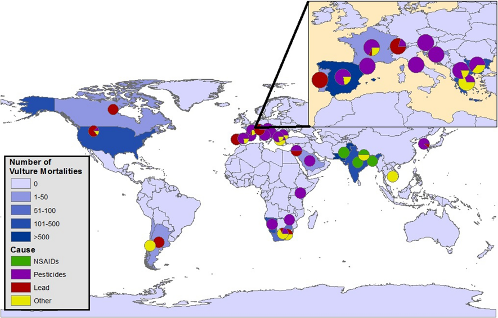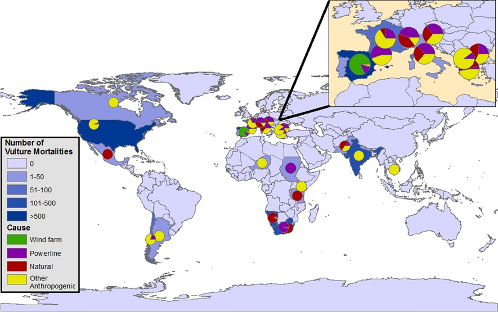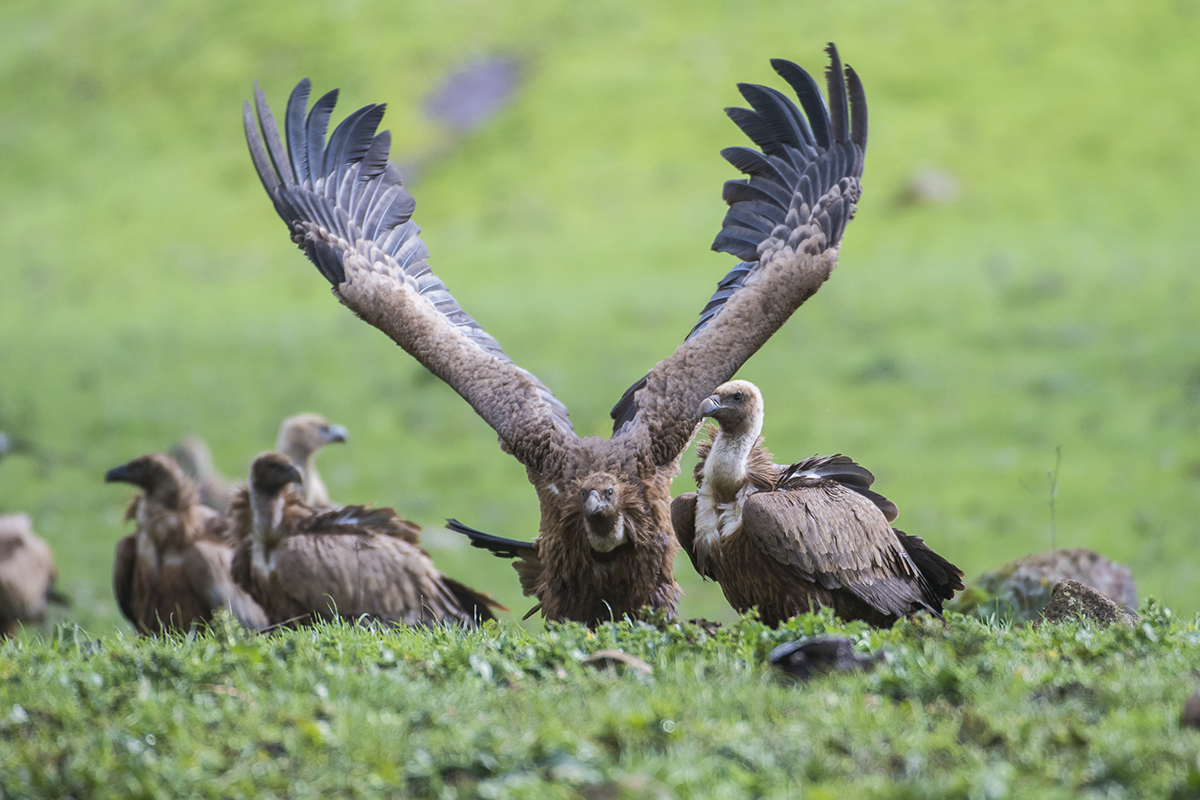A recent systematic review determined the most common causes of morbidity and mortality for wild vultures worldwide.
Scope of the review and methods
The importance of the ecological role of vultures is increasingly recognized, yet their populations are declining worldwide due to the large-scale human-induced transformation of terrestrial ecosystems. For example, ten vulture species are currently listed as Critically Endangered by the IUCN and urgent targeted conservation actions are needed if we want to avoid their extinction in the wild. Despite this precarious status, little research effort has focused on synthesizing the available evidence on primary causes of morbidity and mortality in free-living vultures. Further research on vulture health is crucial to upgrade conservation efforts on wild populations but also to improve captive-breeding programmes.
With this in mind, the authors of this review led by Angela Ives from the Cooke Veterinary Medical Center in the USA, have screened 4593 studies published between 1969 and 2018 focusing on this topic. The data collected included i) vulture species affected; ii) number of vultures affected per species and per cause; iii) the location in which the vultures were studied; iv) and whether the vulture populations of the studies suffered morbidity and/or mortality from the described insult. The cause of vulture morbidity and mortality was classified into the following categories: infectious, trauma, toxic, immune-mediated, inflammatory, neoplastic, metabolic, and idiopathic. The authors reported the results for each cause as percentages corresponding to i) the number of studies reported divided by the total number of studies that met the criteria, and ii) the numbers of vultures affected divided by the total number of individual vultures affected included in the studies. Only 134 studies met the search criteria and were included in the review.
Results
Main causes of morbidity and mortality
The first cause of disease and death in free-living vultures was due to toxicants (reported in 60% of studies and affecting 53% of vultures). Among them, lead was the most recorded toxin (36% of studies), followed by pesticides at 34%, unknown toxins at 20% and non-steroidal anti-inflammatory drugs (NSAIDs) such as diclofenac at 19%.
However, pesticides ranked first in terms of the number of dead individual vultures recorded (48% vs 7% for lead). Among them, organophosphates and carbamates were the most frequent type of pesticides reported (85% of studies and 73% of vultures affected by these pesticides) (see Figure 1).

Traumatic injury was the second most important cause of vulture morbidity and mortality (49% of studies and affecting 41% of the total number of vultures). Anthropogenic causes of trauma were very common, representing 59% of studies and 90% of all vultures reporting trauma. Among them, power line collisions/electrocutions (35%) and gunshots (30%) were ranked first in terms of the number of studies reporting traumas in vultures. However, collisions with wind farms and airstrikes were the main threats in terms of the number of individual vultures affected, 32 and 21% respectively. Predation was the first natural cause of trauma although drowning affected the most vultures (n=212 individuals).

Fewer studies (33%) reported other health-related causes of morbidity and mortality in vultures such as infectious, metabolic, inflammatory or neoplastic diseases in comparison to toxic agents (60%) and trauma (49%). Fungal infectious diseases were the most commonly described with Aspergillus spp. being reported in most studies while Candida spp. affecting most individual vultures. Bacterial and viral diseases were both reported in 6 studies while viral diseases affected more individual vultures (n=36).
Main knowledge gaps in terms of geographic areas and species
Europe accounted both for the majority of studies conducted on vulture health and for the highest proportion of individual vultures with reported morbidity and mortality. South America was ranked last for both the number of studies (3%) and the number of individual vultures (2.5%), with Africa and Asia not being well represented in the final dataset either.
In terms of country, Spain (26%) and the USA (18,5%) accounted for the highest number of studies conducted on vulture health, followed by India and South Africa.
Nineteen species out of 23 vulture species had studies describing patterns of morbidity and mortality. The Griffon vulture Gyps fulvus, the Egyptian vulture Neophron percnopterus and the White-rumped vulture Gyps bengalensis had the highest number of studies of the Old-World Vultures, while the Turkey vulture Cathartes aura and the California condor Gymnogyps californianus had the highest number of studies of the New World vulture species. Unfortunately, several vulture species with unfavourable conservation status had five or less studies in this review, including the Cape vulture Gyps coprotheres, the Himalayan vulture Gyps himalayensis, the Lappet-faced vulture Torgos tracheliotis, the Andean condor Vultur gryphus, and the Hooded vulture Necrosyrtes monachus. Four Critically Endangered species had only one study in this review: Rüppell’s vulture Gyps rueppelli, the Slender-billed vulture Gyps tenuirostris, the Red-headed vulture Sarcogyps calvus, and the White-headed vulture Trigonoceps occipitalis.
Discussion
Main threats to vultures
The findings from this review are in accordance with current literature showing that the ongoing decline in some vulture populations is mainly driven by unsustainable anthropogenic mortality. Toxins and traumatic injury were highlighted as the main causes of morbidity and mortality as shown previously in species-specific case studies.
Several specific ecological traits of vulture species such as their long lifespans, high diet specialization and high trophic levels, make them particularly susceptible to toxin exposure and poisoning (e.g. through bioaccumulation of lead). Communal feeding also explains the large number of individual deaths recorded per poisoning event and further exacerbates the vulnerability of vulture populations. In Europe and Africa, vultures are often poisoned unintentionally by consuming pesticide-laced carcasses disposed of by farmers to eliminate carnivores that have attacked their livestock.
Similarly, lead poisoning is also an unintentional side effect of the use of lead ammunition by hunters and the subsequent contamination of large ungulate carcasses. Although the authors underlined that intentional vulture poisoning by poachers that aimed to divert attention from their activities, has been occurring in certain areas.
The authors also highlighted the potential for several mortality causes to be wrongly assigned (reported drownings could be actually due to undetected pesticide toxicosis) or underrepresented as a result of methodological limitations (NSAID contamination). In-depth toxicological analyses are needed to identify accurately the main cause of vulture mortality.
Again the specific morphology and ranging behaviour of vultures (large gliders using thermals, peripheral vision) make them more vulnerable to traumatic injuries with urban infrastructure (power lines, wind farms and airplanes) than other species. This point explains the importance of tackling these anthropogenic threats for vulture conservation, as highlighted by this review.
Gaps and trends in vulture health research
In addition, little research has focused on understanding the incidence and impact of infectious diseases in vultures. Interestingly, the few studies that have identified fungal infectious diseases in vultures were recorded in individuals with pesticide exposure suggesting that anthropogenic threats weakening immunity could favour pathogen emergence.
Endocrine, nutritional and inflammatory conditions were all poorly represented in vulture health studies and need further attention.
Finally, numerous studies were conducted in Spain and the USA and often ignored endangered species. Therefore, further investigations should focus on threatened vulture species and be conducted in specific geographic areas that have been underrepresented until now like Africa and South America.
Conclusions and conservation actions
In view of the results of this study, several avenues of action were highlighted by the authors including enforcement of laws regulating the use of pesticides, especially in European and African countries; avoiding building and implementing modifications of energy infrastructure through prime vulture habitat; advocating and encourage the use of non-lead ammunition in all terrestrial ecosystems; mitigate predator-livestock conflict and provide non-lethal alternatives to pesticide-laced carcasses; funding for wildlife health, including necropsy services, toxicology laboratories, and public databases for causes of vulture mortality. Several of these research axes and conservation actions are part of VCF projects currently developed in several European countries.
Reference: Ives, A.M., Brenn-White, M., Buckley, J.Y. et al. A Global Review of Causes of Morbidity and Mortality in Free-Living Vultures. EcoHealth (2022). https://doi.org/10.1007/s10393-021-01573-5



